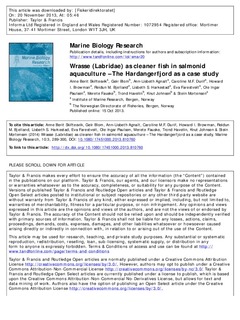| dc.contributor.author | Skiftesvik, Anne Berit | |
| dc.contributor.author | Blom, Geir | |
| dc.contributor.author | Agnalt, Ann-Lisbeth | |
| dc.contributor.author | Durif, Caroline M.F. | |
| dc.contributor.author | Browman, Howard I. | |
| dc.contributor.author | Bjelland, Reidun M. | |
| dc.contributor.author | Harkestad, Lisbeth S. | |
| dc.contributor.author | Farestveit, Eva | |
| dc.contributor.author | Paulsen, Ole Ingar | |
| dc.contributor.author | Fauske, Merete | |
| dc.contributor.author | Havelin, Trond | |
| dc.contributor.author | Johnsen, Knut | |
| dc.contributor.author | Mortensen, Stein | |
| dc.date.accessioned | 2013-11-20T13:50:22Z | |
| dc.date.available | 2013-11-20T13:50:22Z | |
| dc.date.issued | 2013-10-15 | |
| dc.identifier.citation | Anne Berit Skiftesvik, Geir Blom, Ann-Lisbeth Agnalt, Caroline M.F. Durif, Howard I. Browman, Reidun M. Bjelland, Lisbeth S. Harkestad, Eva Farestveit, Ole Ingar Paulsen, Merete Fauske, Trond Havelin, Knut Johnsen & Stein Mortensen (2014) Wrasse (Labridae) as cleaner fish in salmonid aquaculture – The Hardangerfjord as a case study, Marine Biology Research, 10:3, 289-300, DOI: 10.1080/17451000.2013.810760 | no_NO |
| dc.identifier.issn | 1745-1019 | |
| dc.identifier.issn | 1745-1000 | |
| dc.identifier.uri | http://hdl.handle.net/11250/109108 | |
| dc.description.abstract | Several species of wrasse (Labridae) are used as cleaner fish to remove salmon lice from farmed Atlantic salmon. We estimated the fishery and use of wrasse in Hardangerfjord. The estimated numbers of labrids used on salmon and rainbow trout farms varied between 86,000 and 251,000 from 2002–2006, but increased to as much as 1.1 million in 2009 and 2010. A total of 93,500 kg (around 1.54 million) labrids were reported landed during 2000–2010. Corkwing wrasse (Symphodus melops) was by far the most important wrasse species: 52% by weight and 56% by number. Ballan wrasse (Labrus bergylta) made up 34% by weight but only 14% by number (due to its larger size). The relative proportion of species between the different sampling locations in the fjord was significantly different, as was the condition factor of some species. Goldsinny wrasse (Ctenolabrus rupestris) had the slowest growth of the labrids in this study, and did not reach the minimum commercial catch size (11 cm) before they were 4–5 years old. Very few goldsinny caught were over that size. Corkwing reach commercial size in 1–2 years. The results of this study indicate that wrasse should be protected during the spawning season. Species such as goldsinny grow so slowly that they will most likely be collected several times in heavily fished areas but discarded because they are smaller than the minimum allowable size. This could be avoided through the use of modified traps with escape routes for undersized fish. This study represents a first step towards establishing a knowledge-based management plan for the wrasse fishery. | no_NO |
| dc.language.iso | eng | no_NO |
| dc.publisher | Taylor & Francis | no_NO |
| dc.title | Wrasse (Labridae) as cleaner fish in salmonid aquaculture – The Hardangerfjord as a case study | no_NO |
| dc.type | Journal article | no_NO |
| dc.type | Peer reviewed | no_NO |
| dc.subject.nsi | VDP::Agriculture and fishery disciplines: 900::Fisheries science: 920::Aquaculture: 922 | no_NO |
| dc.source.pagenumber | 289-300 | no_NO |
| dc.source.volume | 10 | no_NO |
| dc.source.journal | Marine Biology Research | no_NO |
| dc.source.issue | 3 | no_NO |
| dc.identifier.doi | 10.1080/17451000.2013.810760 | |
| dc.relation.project | Norwegian Seafood Research Fund: 900609 | no_NO |
